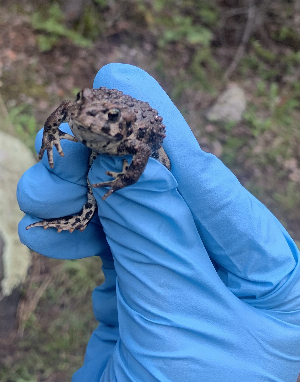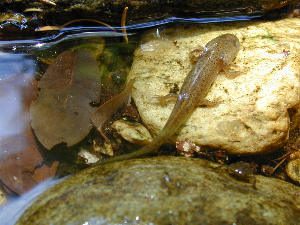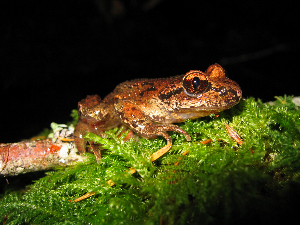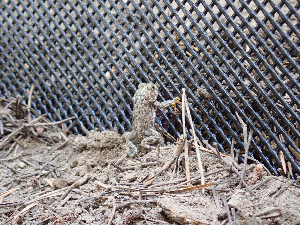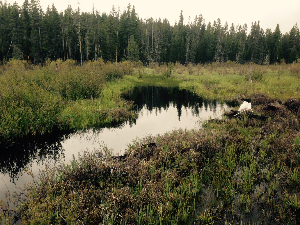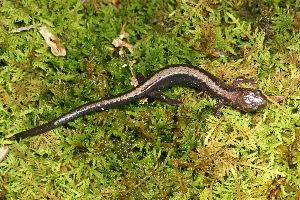Search ARMI Database
Search term(s)
Contribution Number
Search Results
182 record(s) found.
Papers & Reports Comments on: “Rewilding a vanishing taxon–Restoring aquatic ecosystems using amphibians”. Stark and Schwarz 2024. Biological Conservation 292, 110559
Authors: Erin Muths; Benedikt R Schmidt; Evan HC Grant
Date: 2025-01 | Outlet: Biological Conservation
This is a brief response to an article about using amphibians as part of rewilding programs, that points out some flaws in the presentation of ideas in that article.
Papers & Reports Bayesian networks facilitate updating of species distribution and habitat suitability models
Authors: Adam Duarte; Robert S Spaan; James T Peterson; Christopher A Pearl; Michael J Adams
Date: 2024-12-06 | Outlet: Ecological Modelling
Managers often rely on predictions of species distributions and habitat suitability to inform conservation and management decisions. Although numerous approaches are available to develop models to make these predictions, few approaches exist to update existing models as new data accumulate. There is a need for updatable models to ensure good modeling practices in an aim to keep pace with change in the environment and change in data availability to continue to use the best-available science to inform decisions. We demonstrated a workflow to deliver predictive models to user groups within Bayesian networks, allowing models to be used to make predictions across new sites and to be easily updated with new data. To demonstrate this workflow, we focus on species distribution and habitat suitability models given their importance to informing conservation strategies across the globe. In particular, we followed a standard process of collating species encounter data available in online databases and ancillary covariate data to develop a habitat suitability model. We then used this model to parameterize a Bayesian network and updated the model with new data to predict species presence in a new focal ecoregion. We found the network updated relatively quickly as new data were incorporated, and the overall error rate generally decreased with each model update. Our approach allows for the formal incorporation of new data into predictions to help ensure model predictions are based on all relevant data available, regardless of whether they were collected after initial model development. Although our focus is on species distribution and habitat suitability models to inform conservation efforts, the workflow we describe herein can easily be applied to any use case where model uncertainty reduction and increased model prediction accuracy are desired via model updating as new data become available. Thus, our paper describes a generalizable workflow to implement model updating, which is widely recognized as a good modeling practice but is also underutilized in applied ecology.
Papers & Reports Using life history traits to assess climate change vulnerability in understudied species
Authors: Ross K Hinderer; Blake R Hossack; Lisa A Eby
Outlet: Integrative Zoology
Climate change is a primary threat to biodiversity, but for many species, we still lack information required to assess their relative vulnerability to changes. Climate change vulnerability assessment (CCVA) is a widely used technique to rank relative vulnerability to climate change based on species characteristics, such as their distributions, habitat associations, environmental tolerances, and life-history traits. However, for species that we expect are vulnerable to climate change yet are understudied, like many amphibians, we often lack information required to construct CCVAs using existing methods. We used the CCVA framework to construct trait-based models based on life history theory, using empirical evidence of traits and distributions that reflected sensitivity of amphibians to environmental perturbation. We performed CCVAs for amphibians in 7 states in the north-central USA, focusing on 31 aquatic-breeding species listed as species of greatest conservation need by at last 1 state. Because detailed information on habitat requirements is unavailable for most amphibian species, we used species distributions and information on traits expected to influence vulnerability to a drying climate (e.g., clutch size and habitat breadth). We scored species vulnerability based on changes projected for mid-century (2040?2069) from 2 climate models representing “least-dry” and “most-dry” scenarios for the region. Species characteristics useful for discriminating vulnerability in our models included small range size, small clutch size, inflexible diel activity patterns, and smaller habitat breadth. When projected climate scenarios included a mix of drier and wetter conditions in the future, the exposure of a species to drying conditions was most important to relative rankings. When the scenario was universally drier, species characteristics were more important to relative rankings. Using information typically available even for understudied species and a range of climate projections, our results highlight the potential of using life history traits as indicators of relative climate vulnerability. The commonalities we identified provide a framework that can be used to assess other understudied species threatened by climate change.
Papers & Reports Unburned habitat essential for amphibian breeding persistence following wildfire.
Authors: Larissa L Bailey; Richard Henderson; Wendy A Estes-Zumpf; Charles Rhoades; Ellie Miller; Dominique Lujan; Erin Muths
Date: 2025 | Outlet: Global Ecology and Conservation, 57, p.e03389.
Wildfire regimes are changing rapidly with widespread increase in the intensity, frequency, and duration of fire activity, especially in the western United States. Limited studies explore the impacts of wildfires on aquatic taxa and few focus on lentic habitats that are essential for amphibians, many of which are of conservation concern. We capitalized on existing pre-fire surveys for anuran species and resurveyed a random subset of wetlands across a gradient of soil burn severity to investigate the short-term effects of wildfire on a relict population of wood frogs in the southern Rocky Mountains. We also investigated whether maps created to support rapid post-fire emergency response activities (i.e., USFS BAER program) accurately characterize soil burn severity around small habitat features (i.e., ponds) that serve as important amphibian breeding and rearing habitat. We found that wood frog breeding persistence following fires was strongly influenced by the percentage of their terrestrial habitat (100m buffer surrounding breeding ponds) that was burned. Wood frog colonization probability of previously unoccupied ponds was low (~ 0.10) and unaffected by soil burn severity. Importantly, we found that remotely sensed data typically produced to predict flooding and erosion at broad (catchment) scales is a poor representation of the amount and variation in soil burn severity surrounding small habitat features (e.g., ponds), suggesting that additional field sampling is necessary to understand wildfire responses for species that rely on small habitat features. Understanding short-term geographic- and species-specific variation in response to wildfires provides the basis to explore time to recovery (e.g., when wood frogs return to burned breeding sites) or to determine if declines in breeding distributions intensify over time.
Papers & Reports Informative priors can account for location uncertainty in stop-level analyses of the North American Breeding Bird Survey (BBS), allowing fine-scale ecological analyses
Authors: Ryan C Burner; Alan Kirschbaum; Jeffrey A. Hostetler; David J. Ziolkowski Jr; Nicholas M. Anich; Daniel Turek; Eli D. Striegel; Neal D. Niemuth
Date: 2024-09-14 | Outlet: Ornithological Applications
Ecologists can learn a lot about species by studying the precise locations in which they do (and do not) occur, but the location information associated with many species records is imprecise. A prominent example of this is the North American Breeding Bird Survey (BBS), in which volunteer observers have surveyed birds at points along consistent routes across the United States for over fifty-five years. As the BBS was designed for large-scale analyses, detailed location information for each bird count is not recorded. We estimate location uncertainty, and the resulting uncertainty in land cover covariates, for the BBS data and present a modeling method that accounts for this uncertainty in a way that opens new possibilities for fine-scale uses of this extensive dataset, unlocking its potential to advance the study of the relationships between birds and their immediate habitat. More broadly, our methods and modeling framework could be used in a variety of situations in which covariate or location uncertainty is a challenge.
Papers & Reports Decision analysis and adaptive management: strategies to overcome challenges of uncertainty and inaction.
Authors: Katherine M O'Donnell; Evan HC Grant
Outlet: Society for the Study of Amphibians and Reptiles Herpetological Conservation Series
A book chapter highlighting uncertainty and inaction in conservation, decision analysis steps and challenges and decision analysis for amphibians and reptiles
Papers & Reports Of toads and tolerance: Quantifying intraspecific variation in host resistance and tolerance to a lethal pathogen
Authors: Bennett Hardy; Erin Muths; W C Funk; Larissa L Bailey
Date: 2024-05-30 | Outlet: Journal of Animal Ecology
Due to the ubiquity of disease in natural systems, hosts have evolved strategies of disease resistance and tolerance to defend themselves from further harm once infected. Resistance strategies directly limit pathogen growth, typically leading to lower infection burdens in the host. A tolerance approach limits the fitness consequences caused by the pathogen but does not directly inhibit pathogen growth. Testing for intraspecific variation in wild host populations is important for informing conservation decisions about captive breeding, translocation, and disease treatment. Here, we test for the relative importance of tolerance and resistance in multiple populations of boreal toads (Anaxyrus boreas boreas) against Batrachochytrium dendrobatidis (Bd), the amphibian fungal pathogen responsible for the greatest host biodiversity loss due to disease. Boreal toads have severely declined in Colorado (CO) due to Bd, but toad populations challenged with Bd in western Wyoming (WY) appear to be less affected. We used a common garden infection experiment to expose post-metamorphic toads sourced from four populations (2 in CO and 2 in WY) to Bd and monitored changes in mass, pathogen burden, and survival for eight weeks. We used a multi-state modeling approach to estimate weekly survival and transition probabilities between infected and cleared states, reflecting a dynamic infection process that traditional approaches fail to capture. We found that WY boreal toads are highly tolerant to Bd infection with higher survival probabilities than those in CO when infected with identical pathogen burdens. WY toads also had higher probabilities of clearing infections and took an average of five days longer to reach peak infection burdens. Our results demonstrate strong intraspecific differences in tolerance and resistance that explain why population declines vary regionally across the species. We used a robust, multi-state framework to gain inference on typically hidden disease processes when testing for host tolerance or resistance and demonstrated that describing an entire species as ‘tolerant’ or ‘resistant’ is unwise without testing for intraspecific variation in host defenses.
Papers & Reports Matching decision support modeling frameworks to disease emergence stages
Authors: Evan HC Grant; Brittany A Mosher; Riley F Bernard; Alexander D Wright; Robin E Russell
Wildlife disease management decisions often require rapid responses to situations that are fraught with uncertainty. By recognizing that management is implemented to achieve specific objectives (whether defined explicitly or not), resource managers and science partners can identify an analysis technique and develop a plan to collect necessary data that will allow for the evaluation of management actions.
Papers & Reports Hiding in plain sight: federally protected Ringed Map Turtles, Graptemys oculifera, found in a new river system
Authors: Brad M Glorioso; Will Selman; B R Kreiser; Aidan Ford
Date: 2024-04-30 | Outlet: Herpetological Conservation and Biology
Understanding the geographical range of a species is essential to successful conservation and management, but their ranges are not always fully known. Ringed Map Turtles, Graptemys oculifera, have been federally listed as a threatened species since 1986, and they have long been considered endemic to the Pearl River system of central Mississippi and southeastern Louisiana. By way of a 2021 citizen scientist observation, a new G. oculifera population was discovered in the Bogue Falaya, a river system that is west of and isolated from the Pearl River system. Genetic analyses of 23 individuals from the Bogue Falaya demonstrate their distinctiveness relative to sites in the Pearl River, suggesting it is a natural rather than introduced population. Therefore, G. oculifera should no longer be considered endemic to the Pearl River system, and this Bogue Falaya population of G. oculifera may warrant the designation of a distinct population segment under the Endangered Species Act. A thorough assessment of the distribution, abundance, and conservation threats to the Bogue Falaya population of G. oculifera is needed as well as surveys of surrounding systems. This discovery of a long federally protected species in the city limits of Covington, Louisiana, underscores the need for more surveys to fully understand species distributions and documents how citizen scientists can advance scientific knowledge.
Papers & Reports Genetic Connectivity in the Arizona toad (Anaxyrus microscaphus): implications for conservation of a stream dwelling amphibian in the arid Southwestern U.S.
Authors: S J Oyler-McCance; Mason J Ryan; Brian K Sullivan; Jennifer A Fike; R Cornman; J T Giermakowski; Shawna J Zimmerman; Rachel L Harrow; S Hedwall; Blake R Hossack; I M Latella; Robert E Lovich; Sarah Siefken; Brent H Sigafus; Erin Muths
Outlet: Conservation Genetics
The Arizona Toad (Anaxyrus microscaphus) is restricted to riverine corridors and adjacent uplands in the arid southwestern United States. As with numerous amphibians worldwide, populations are declining and face various known or suspected threats, from disease to habitat modification resulting from climate change. The Arizona Toad has been petitioned to be listed under the U.S. Endangered Species Act and was considered “warranted but precluded” citing the need for additional information – particularly regarding natural history (e.g., connectivity and dispersal ability). The objectives of this study were to characterize population structure and genetic diversity across the species’ range. We used reduced-representation genomic sequencing to genotype 3,601 single nucleotide polymorphisms in 99 Arizona Toads from ten drainages across its range. Multiple analytical methods revealed two distinct genetic groups bisected by the Colorado River; one in the northwestern portion of the range in northwestern Arizona, southwestern Utah, and eastern Nevada and the other in the southeastern portion of the range in central and eastern Arizona and New Mexico. We also found subtle substructure within both groups, particularly in central Arizona where toad populations in lower elevations were less connected than those at higher elevations. The northern and southern parts of the Arizona Toad range are not well connected genetically and could be managed as separate units. Further, these data could be used to identify source populations for assisted migration or translocations to support small or potentially declining populations.
Papers & Reports Native amphibian toxin reduces invasive crayfish feeding with potential benefits to stream biodiversity
Authors: Gary Bucciarelli; Sierra J. Smith; Justin J. Choe; Phoebe D. Shin; Robert N Fisher; Lee B Kats
Date: 2023-09-13 | Outlet: BMC Ecology and Evolution 23, 51
Biodiversity is generally reduced when non-native species invade an ecosystem. Invasive crayfish, Procambarus clarkii, populate California freshwater streams, and in the Santa Monica Mountains (Los Angeles, USA), their introduction has led to trophic cascades due to omnivorous feeding behavior and a rapid rate of population growth. The native California newt, Taricha torosa, possesses a neurotoxin, tetrodotoxin (TTX), that affects freshwater animal behavior. Given P. clarkii has a limited evolutionary history with TTX, we hypothesized that TTX may affect crayfish feeding behaviors. To determine if TTX affects P. clarkii behavior, we measured cumulative movement and various feeding behaviors of P. clarkii exposed to (i) waterborne, ecologically realistic concentrations of TTX (~?3.0?×?10??8 moles/L), (ii) an anuran chemical cue to account for intraguild cues, or (iii) a T. torosa chemical cue with quantitated TTX in it (~?6.2?×?10??8 moles/L).
Results
We found that the presence of TTX in any form significantly reduced crayfish movement and decreased the amount of food consumed over time. Crayfish responses to the anuran treatment did not significantly differ from controls.
Conclusion
Our laboratory results show that naturally occurring neurotoxin from native California newts limits invasive crayfish foraging and feeding rates, which may play a role in preserving local stream ecosystems by limiting invasive crayfish behaviors that are detrimental to biodiversity.
Results
We found that the presence of TTX in any form significantly reduced crayfish movement and decreased the amount of food consumed over time. Crayfish responses to the anuran treatment did not significantly differ from controls.
Conclusion
Our laboratory results show that naturally occurring neurotoxin from native California newts limits invasive crayfish foraging and feeding rates, which may play a role in preserving local stream ecosystems by limiting invasive crayfish behaviors that are detrimental to biodiversity.
Papers & Reports Adjacent and downstream effects of forest harvest on the distribution and abundance of larval headwater stream amphibians in the Oregon Coast Range
Authors: Adam Duarte; Nathan D Chelgren; Jennifer C Rowe; Christopher A Pearl; Sherri L. Johnson; Michael J Adams
Date: 2023-07-21 | Outlet: Forest Ecology and Management
Forest harvest is a primary landscape-scale management action affecting riparian forests. Although concerns about impacts of forest harvest on stream amphibians is generally limited to areas adjacent to harvest, there is a paucity of information regarding potential downstream effects of forest harvest on these species. We designed a before-after, control-impact (BACI) experiment to quantify potential impacts of clearcut logging that included 12-m buffers or smaller variable-width buffers on the distribution and abundance of headwater stream amphibians in adjacent and downstream areas. We sampled larval coastal tailed frogs (Ascaphus truei), coastal giant salamanders (Dicamptodon tenebrosus), and Columbia torrent salamanders (Rhyacotriton kezeri) across 3,915 sampling occasions that spanned 13 study reaches in 2008–2011 (pre-harvest) and 2013–2016 (post-harvest) as part of the Trask River Watershed Study in the Oregon Coast Range, U.S.A. We analyzed these data using occupancy models to estimate occupancy and (when possible) relative abundance, while accounting for various sources of imperfect detection. All species exhibited reduced occupancy adjacent to clearcuts with variable-width buffers (odds ratios [ORs] ranged = 0.24–0.48), and these negative impacts were not always diminished when increasing the buffer size to 12 m (ORs ranged = 0.20–3.56). Dicamptodon tenebrosus was the only species to have occupancy impacted in downstream areas, and this negative impact was related to clearcut logging with uniform 12-m buffers (OR = 0.60). This species was also the only species to have abundance negatively impacted by forest harvest in downstream areas (OR = https://0.41 with uniform 12-m buffers, OR = https://0.38 with variable-width buffers), albeit impacts to abundance were not evaluated for R. kezeri. Ascaphus truei abundance increased in areas downstream of clearcut logging with uniform 12-m buffers (OR = 2.92). Although we found the direction and magnitude of responses varied by species, our study confirms that clearcut logging can have negative impacts on amphibians that inhabit the adjacent stream areas. Perhaps more importantly, we also found that forest harvest can have negative effects on stream amphibians downstream of the harvested area and that increasing the buffer size to 12 m did not necessarily diminish these impacts in adjacent and downstream areas. Altogether, our study provides a nuanced picture of adjacent and downstream effects of forest harvest on three endemic headwater stream amphibians, and our findings demonstrate that forest management practices should consider downstream effects on aquatic taxa when assessing the impact of harvesting trees near headwater streams.
Papers & Reports Successful eradication of invasive American bullfrogs leads to co-extirpation of emerging pathogens
Authors: Blake R Hossack; D Hall; C L Crawford; Caren S Goldberg; Erin Muths; Brent H Sigafus; Thierry C Chambert
Date: 2023 | Outlet: Conservation Letters
Interventions of host-pathogen dynamics provide strong tests of relationships, yet they are still rarely applied across multiple populations. After American Bullfrogs (Rana catesbeiana) invaded a wildlife refuge where federally threatened Chiricahua Leopard Frogs (R. chiricahuensis) were reintroduced 12 years prior, managers launched a landscape-scale eradication effort to help ensure continued recovery of the native species. We used a before-after-control-impact (BACI) design and environmental DNA sampling of 19 eradication sites and 18 control sites between fall 2016 and winter 2020–2021 to measure community-level responses to bullfrog eradication, including for 2 pathogens. Dynamic occupancy models revealed successful eradication from 94% of treatment sites. Native amphibians did not respond to bullfrog eradication, but the pathogens amphibian chytrid fungus (Batrachochytrium dendrobatidis) and ranaviruses were co-extirpated with bullfrogs. Our spatially replicated experimental approach provides strong evidence that management of invasive species can simultaneously reduce predation and disease risk for imperiled species.
Papers & Reports Prioritizing the risk and management of introduced species in a landscape with high indigenous biodiversity
Authors: Jonathan Q Richmond; Jennifer Kingston; Brittany Ewing; Wendy Bear; Stacie A Hathaway; Cedric Lee; Camm C. Swift; Kristine L Preston; Allison J Schultz; Barbara E. Kus; Kerwin Russel; Philip Unitt; B Hollingsworth; Robert E Espinoza; Michael Wall; S Tremor; Kai Palenscar; Robert N Fisher
Date: 2023 | Outlet: Bulletin of the Southern California Academy of Sciences
Risk analysis protocols for prioritizing the management of non-native species are numerous, yet few incorporate risk and management in the same analysis or accommodate a broad diversity of taxa outside of a specific geographic area. We adapted a protocol that accounts for these factors to address non-native animal species in the Southern California/Northern Baja California Coast Ecoregion near the international border in San Diego County, an area with high indigenous biodiversity and high numbers of species of conservation concern. This stepwise, semi-quantitative protocol is applicable to any animal group in any predefined geographic area, relies on consensus-building among taxonomic experts, and has been vetted through previous use and in peer-reviewed literature. Our results show that the final prioritization was driven mainly by management feasibility, with top-ranked species having multitrophic effects that favor other non-native invaders over native residents. Conditions within the assessment area required some modification to the protocol as it was originally designed, namely a shift in emphasis from eradication to control, given that eradication is implausible for most non-native species in the assessment area. We call attention to taxon-specific issues that surfaced during the analysis, identify areas for improvement in this first-ever risk assessment for invasive animal species in the Natural Communities Conservation Plan/Habitat Conservation Plan (NCCP/HCP) reserve system of San Diego County, and provide suggestions for further refinement of the protocol. This study builds on the effort to standardize risk analysis for invasive species globally, given that many of the same invaders present threats to indigenous biodiversity worldwide.
Papers & Reports Elevated road segment (ERS) passage design may provide enhanced connectivity for amphibians, reptiles, and small mammals
Authors: Cheryl S Brehme; Stephanie Barnes; Brittany Ewing; Philip Gould; Cassie Vaughan; Michael Hobbs; Charles Tornaci; Sarah Holm; Hanna Sheldon; Jon Fiutak; Robert N Fisher
Date: 2023-05-24 | Outlet: Frontiers in Ecology and Evolution 11:1145322
Introduction: Designs for safe and effective road crossing structures for small animals are typically under-road microtunnels and culverts which have varying levels of effectiveness reported in the scientific literature. Many species, particularly migratory amphibians, may have limited ability to find and use passages if they are too far apart, resulting in substantial barrier effects.
Methods: We designed a novel open elevated passage (elevated road segment: ERS), similar to a low terrestrial bridge, that could theoretically be built to any length based upon species needs and movement characteristics. A 30 m length prototype ERS was installed along a forest road with a history of amphibian road mortality in Sierra National Forest, Fresno County, CA, USA. From 2018 to 2021, we monitored small animal activity under the ERS in relation to surrounding roadside and forest habitats using active infrared cameras.
Results: We documented a total of 8,815 unique use events, using species specific independence criteria, across 22 species of amphibians (3), reptiles (4), and small mammals (15). Poisson regression modeling of taxonomic group activity under the ERS, roadside and forest, showed that amphibian activity was highest in the forest habitat, no differences were observed for reptiles, and small mammal activity was highest under the ERS. However, mean activity estimates under the ERS were equal to or greater than the open roadside habitat for all 22 species, suggesting that adding cover objects, such as downed logs and vegetation may further enhance passage use.
Discussion: Overall, results showed that the design of the ERS crossing has potential to provide high connectivity for a wide range of amphibian, reptile, and small mammal species while reducing road mortality. ERS systems can also be used in areas with challenging terrain and other hydrological and environmental constraints. Incorporating current road ecology science, we provide supplemental ERS concept designs for secondary roads, primary roads and highways to help increase the options available for road mitigation planning for small animals.
Methods: We designed a novel open elevated passage (elevated road segment: ERS), similar to a low terrestrial bridge, that could theoretically be built to any length based upon species needs and movement characteristics. A 30 m length prototype ERS was installed along a forest road with a history of amphibian road mortality in Sierra National Forest, Fresno County, CA, USA. From 2018 to 2021, we monitored small animal activity under the ERS in relation to surrounding roadside and forest habitats using active infrared cameras.
Results: We documented a total of 8,815 unique use events, using species specific independence criteria, across 22 species of amphibians (3), reptiles (4), and small mammals (15). Poisson regression modeling of taxonomic group activity under the ERS, roadside and forest, showed that amphibian activity was highest in the forest habitat, no differences were observed for reptiles, and small mammal activity was highest under the ERS. However, mean activity estimates under the ERS were equal to or greater than the open roadside habitat for all 22 species, suggesting that adding cover objects, such as downed logs and vegetation may further enhance passage use.
Discussion: Overall, results showed that the design of the ERS crossing has potential to provide high connectivity for a wide range of amphibian, reptile, and small mammal species while reducing road mortality. ERS systems can also be used in areas with challenging terrain and other hydrological and environmental constraints. Incorporating current road ecology science, we provide supplemental ERS concept designs for secondary roads, primary roads and highways to help increase the options available for road mitigation planning for small animals.
Papers & Reports By land, air, and water – USGS science supporting fish and wildlife migrations throughout North America
Authors: Mona Khalil; Mark Wimer; David Hu; Michael J Adams; Melanie Steinkamp; Suzanna C Soileau
Date: 2022-06-22
Countless species of animals—big game, birds, bats, insects, amphibians, reptiles, and fish—migrate to reach suitable habitats to feed, reproduce, and raise their young. Animal migrations developed over millennia commonly follow migration corridors—unique routes for each species—to move among seasonal habitats. Changes along those corridors, whether from human development (buildings, roads, dams) or from natural disturbances (for example, climate change, drought, fire, flooding, or invasive species), can make them harder to navigate. The U.S. Geological Survey’s Ecosystems Mission Area provides science that assists land managers in mapping, enhancing, protecting, and reconnecting migration corridors critical for diverse fish and wildlife populations that migrate, such as Odocoileus hemionus (mule deer) and Antilocapra americana (pronghorn), trout and salmon, salamanders, tortoises, bats, and Danaus plexippus (monarch butterflies).
Papers & Reports Looking ahead, guided by the past: The role of U.S. national parks in amphibian research and conservation
Authors: Brian J Halstead; Andrew M Ray; Erin Muths; Evan HC Grant; Rob L Grasso; Michael J Adams; Katy S Delaney; Jane Carlson; Blake R Hossack
Date: 2022-03 | Outlet: Journal of Ecological Indicators 136: 108631
Protected areas like national parks are essential elements of conservation because they limit human influence on the landscape, which protects biodiversity and ecosystem function. The role of national parks in conservation, however, often goes far beyond limiting human influence. The U.S. National Park Service and its system of land units contribute substantively to conservation by providing protected lands where researchers can document trends in species distributions and abundances, examine characteristics important for generating these trends, and identify and implement conservation strategies to preserve biodiversity. We reviewed the contribution of U.S. national parks to amphibian research and conservation and highlight important challenges and findings in several key areas. First, U.S. national parks were instrumental in providing strong support that amphibian declines were real and unlikely to be simply a consequence of habitat loss. Second, research in U.S. national parks provided evidence against certain hypothesized causes of decline, like UV-B radiation, and evidence for others, such as introduced species and disease. However, describing declines and identifying causes contributes to conservation only if it leads to management; importantly, U.S. national parks have implemented many conservation strategies and evaluated their effectiveness in recovering robust amphibian populations. Among these, removal of invasive species, especially fishes; conservation translocations; and habitat creation and enhancement stand out as examples of successful conservation strategies with broad applicability. Successful management for amphibians is additionally complicated by competing mandates and stakeholder interests; for example, past emphasis on increasing visitor enjoyment by introducing fish to formerly fishless lakes had devastating consequences for many amphibians. Other potential conflicts with amphibian conservation include increasing development, increased risk of introductions of disease and exotic species with increased visitation, and road mortality. Decision science and leveraging partnerships have proven to be key components of effective conservation under conflicting mandates in national parks. As resource managers grapple with large-scale drivers that are outside local control, public-private partnerships and adaptive strategies are increasing in importance. U.S. national parks have played an important role in many aspects of identifying and ameliorating the amphibian decline crisis and will continue to be essential for the conservation of amphibians in the future.
Papers & Reports Population Dynamics of the Threatened Oregon Spotted Frog (Rana pretiosa) Before and After Drought Mitigation
Authors: Jennifer C Rowe; Christopher A Pearl; Adam Duarte; Brome McCreary; Michael J Adams
Date: 2023-09-22 | Outlet: The Journal of Wildlife Management
Amphibians are among the most sensitive taxa to climate change, and species inhabiting arid and semiarid landscapes at the extremes of their range are especially vulnerable to drought. The Jack Creek, Oregon, USA, population of Oregon spotted frogs (Rana pretiosa) faces unique challenges because it occupies the highest elevation site in the species' extant range and one that has been transformed by loss of American beavers (Castor canadensis[/]), which historically maintained open water. We evaluated the effects of drought mitigation (addition of excavated ponds) on relationships between local and regional water availability, inactive legacy beaver dams, and Oregon spotted frog population dynamics in the Jack Creek system. We conducted egg mass surveys and capture-mark-recapture sampling at a treatment reach with excavated ponds and 3 reference reaches over 13 years; surveys spanned a period before and after pond excavation at the treatment and 1 primary comparison reference reach. We analyzed data using a combination of robust design capture-mark-recapture estimators and generalized linear mixed models to characterize population dynamics. Adult Oregon spotted frog survival was approximately 19.5% higher at the treatment reach than the primary reference reach during the study period. Annual survival was most strongly associated with late summer vegetation greenness, a proxy for water availability, and males had higher survival than females. Among the 4 study reaches, the treatment reach consistently had higher late summer vegetation greenness, and the hydrology functioned more independently of regional precipitation patterns relative to the reference reaches; however, these dynamics were not linked to pond excavation. Breeding was concentrated in 2 legacy beaver ponds that were deepened by excavation during the study compared to an unexcavated beaver pond, 2 excavated ponds without legacy beaver dams, and 9 reference ponds. These results point to the benefit of enhancing existing beaver structures and indicate that management actions aimed at maintaining surface water for breeding in spring and saturated soils and ponded water for adults in late summer would benefit this unique population of Oregon spotted frogs in the face of drought.
Papers & Reports Research Needs to Inform Amphibian Conservation in the Anthropocene
Authors: Evan HC Grant; Staci M Amburgey; Brian Gratwicke; Victor Acosta Chaves; Anat M Belasen; David Bickford; Carsten Bruhl; Natalie E Calatayud; Nick Clemann; Simon Clulow; Jeff Dawson; David A DeAngelis; Kenneth C Dodd; Annette Evans; Gentile Francesco Ficetola; Mattia Falaschi; Sergio Gonzalez-Mollinedo; D M Green; Roseanna Gamlen-Greene; Richard A Griffiths; Brian J Halstead; Craig Hassapakis; Geoffrey Heard; Catharina Karlsson; Tom Kirschey; Brittany A Kosch; Sophia Kusterko Novaes; Luke Linhoff; John C Maerz; Brittany A Mosher; Katherine M O'Donnell; Leticia M Ochoa-Ochoa; J D Roberts; A Silla; Tariq Stark; Jeanne Tarrant; R Upton; Judit Voros; Erin Muths
Date: 2023 | Outlet: Conservation Science and Practice
The problem of global amphibian declines has prompted extensive research over the last three decades; initially the focus was on identifying and characterizing the extent of the problem, but more recently efforts have shifted to evidence-based research designed to improve conservation outcomes. Using input from participants at the 9th World Congress of Herpetology, a US Geological Survey Powell Center symposium, amphibian listservs, the IUCN Assisted Reproductive Technologies and Gamete Biobanking group, and respondents to a survey, we developed a list of 25 priority research questions for amphibian conservation at this stage of the Anthropocene. These research needs represent critical knowledge gaps for amphibian conservation.
Papers & Reports Abiotic and biotic factors reduce the viability of a high-elevation salamander in its native range
Authors: Evan HC Grant; Graziella V DiRenzo; Adrianne B Brand
Date: 2023-05-20 | Outlet: Journal of Applied Ecology
1. Amphibian populations are undergoing worldwide declines, and high-elevation, range-restricted amphibian species may be particularly vulnerable to environmental stressors. In particular, future climate change may have disproportional impacts to these ecosystems. Evaluating the combined effects of abiotic changes and biotic interactions simultaneously is important for forecasting the range of future outcomes. This information is necessary to aid conservation decision-making.
2. We use field data to estimate population demographic parameters for an exemplary high-elevation amphibian species, the federally endangered Shenandoah salamander (Plethodon shenandoah). These parameters were entered into a Markov projection model which we used to forecast the future population status of the Shenandoah salamander.
3. We found that if the population maintains its current site colonization and persistence rates, it is at risk of extinction that could be exacerbated by both climate and interspecific competition.
4. Synthesis and applications. Managers have a fundamental objective directed by official policy of maintaining the species ‘for the foreseeable future (Grant et al., 2014).’ Our evaluation of multiple hypotheses about population drivers reveals that extinction is projected for this species. Our analysis suggests that considering active management need not depend on resolving the uncertainty.
2. We use field data to estimate population demographic parameters for an exemplary high-elevation amphibian species, the federally endangered Shenandoah salamander (Plethodon shenandoah). These parameters were entered into a Markov projection model which we used to forecast the future population status of the Shenandoah salamander.
3. We found that if the population maintains its current site colonization and persistence rates, it is at risk of extinction that could be exacerbated by both climate and interspecific competition.
4. Synthesis and applications. Managers have a fundamental objective directed by official policy of maintaining the species ‘for the foreseeable future (Grant et al., 2014).’ Our evaluation of multiple hypotheses about population drivers reveals that extinction is projected for this species. Our analysis suggests that considering active management need not depend on resolving the uncertainty.




